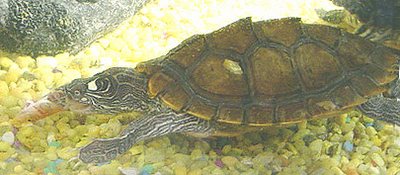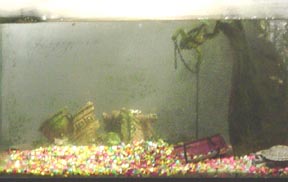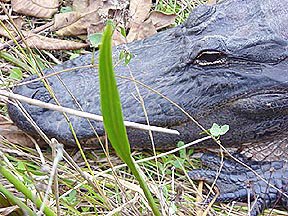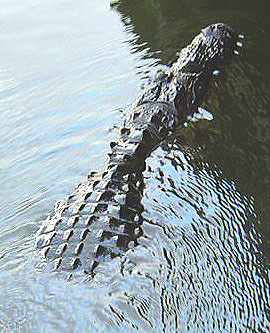 I have a Map Turtle that was purchased as a small baby (for educational purposes) and is now about five inches long. The serrated scales on the side of the shell are pretty cool. The Turtle also has a highly detailed skin featuring yellow stripes on her dark green skin. After the Mud Turtle died, we wanted to get another friend for the little red-ear slider. Small Mud & Musk Turtles are rarely available in the average Reptile store, and especially in the Fall months. So we found a baby Map Turtle, and he is getting along fine with the baby Red-Ear and the small Musk Turtle. One big happy family. That is a great thing about turtles. They usually get along very well, and they seem to live in harmony except when they are trying to get the same piece of food. They climb on each other to bask in the sunlight, and they do not seem to have any major hang-ups!
I have a Map Turtle that was purchased as a small baby (for educational purposes) and is now about five inches long. The serrated scales on the side of the shell are pretty cool. The Turtle also has a highly detailed skin featuring yellow stripes on her dark green skin. After the Mud Turtle died, we wanted to get another friend for the little red-ear slider. Small Mud & Musk Turtles are rarely available in the average Reptile store, and especially in the Fall months. So we found a baby Map Turtle, and he is getting along fine with the baby Red-Ear and the small Musk Turtle. One big happy family. That is a great thing about turtles. They usually get along very well, and they seem to live in harmony except when they are trying to get the same piece of food. They climb on each other to bask in the sunlight, and they do not seem to have any major hang-ups!
Wednesday, December 22, 2004
Map Turtle
 I have a Map Turtle that was purchased as a small baby (for educational purposes) and is now about five inches long. The serrated scales on the side of the shell are pretty cool. The Turtle also has a highly detailed skin featuring yellow stripes on her dark green skin. After the Mud Turtle died, we wanted to get another friend for the little red-ear slider. Small Mud & Musk Turtles are rarely available in the average Reptile store, and especially in the Fall months. So we found a baby Map Turtle, and he is getting along fine with the baby Red-Ear and the small Musk Turtle. One big happy family. That is a great thing about turtles. They usually get along very well, and they seem to live in harmony except when they are trying to get the same piece of food. They climb on each other to bask in the sunlight, and they do not seem to have any major hang-ups!
I have a Map Turtle that was purchased as a small baby (for educational purposes) and is now about five inches long. The serrated scales on the side of the shell are pretty cool. The Turtle also has a highly detailed skin featuring yellow stripes on her dark green skin. After the Mud Turtle died, we wanted to get another friend for the little red-ear slider. Small Mud & Musk Turtles are rarely available in the average Reptile store, and especially in the Fall months. So we found a baby Map Turtle, and he is getting along fine with the baby Red-Ear and the small Musk Turtle. One big happy family. That is a great thing about turtles. They usually get along very well, and they seem to live in harmony except when they are trying to get the same piece of food. They climb on each other to bask in the sunlight, and they do not seem to have any major hang-ups!
Thursday, December 16, 2004
Wednesday, December 15, 2004
Little Red Eared Slider
 We visited a local reptile pet store as we often do to look at the many interesting critters. I guess it is called window shopping. The usual suspects were there, incarcerated in their terrariums and aquariums, and some were in little plastic trays. The feeder rats, mice, pinkies, and bloods had just been delivered. You could see the big rats red eyes were looking for a way out as they scrambled around in their delivery crates.
We visited a local reptile pet store as we often do to look at the many interesting critters. I guess it is called window shopping. The usual suspects were there, incarcerated in their terrariums and aquariums, and some were in little plastic trays. The feeder rats, mice, pinkies, and bloods had just been delivered. You could see the big rats red eyes were looking for a way out as they scrambled around in their delivery crates. Spotted a batch of small red-eared sliders. These guys were very young and full of pep. The red-eared sliders were $5. each, the snapping turtles were $25. and the soft-shell, map turtles, and painted turtles were $20. each. Three of the turtles in our aquarium were now getting close to five inches long and they were purchased as little babies originally (for educational purposes).
Picked a very energetic little fellow. He/she is doing great so far, getting lots of sun and artificial lighting at the basking places in a long twenty gallon aquarium. Reptile aquariums are horizontally longer and vertically shorter.
Wednesday, December 01, 2004
Alligator hunting for snacks?
Releasing Turtles into the Wild
 Have you ever seen any animals kept in overcrowded conditions at a Pet Shop?? Most Pet Shops are very conscientious and try very hard to treat animals in a humane manner.
Have you ever seen any animals kept in overcrowded conditions at a Pet Shop?? Most Pet Shops are very conscientious and try very hard to treat animals in a humane manner. However, there are exceptions to every rule. But what can I do about it? A complaint to the Health Department might get some action. On the other hand, the Pet Store may be in compliance anyhow, or the overcrowded or unsanitary condition may have been resolved by the time it is investigated.
So if you could afford it, would you love to buy all the animals in stock and free them? For captive-born creatures like hamsters, snakes, dogs, cats, etc. it would be extremely deadly for the animals if they were just released at the local park.
But what about critters like Iguanas and Turtles?? You would think that if a bunch of large pet store stock turtles that were indiginous to the area were released back into a local lake that there could be no damage to the critters or the people?
It is a romantic notion to what to free animals that seem to be neglected, however most creatures lose their ability to compete in the wild once they have been living in a small aquarium or cage for a few months.
Once they lose a step, catching wild fish or other food may almost be impossible. So instead of liberating them from neglect, they become tourists in a wild environment where they do not belong. Either they slowly starve, or they get sick or they are eaten by faster and stronger wild creatures. So releasing our reptile friends back into the wild is not a responsible option.
The other possible repercussion is that turtles and other reptiles can pick up illnesses and parasites from other turtles and reptiles that they were penned together with. The cross-infecting of species is a major problem caused by the Pet Trade.
So if you release formerly captive reptiles into the wild, and they were infected with an illness that is native to another type of turtle or reptile, then that infection can spread to the local indiginous species of turtles or reptiles causing what amounts to be a plague. Therefore releasing captive animals is not good because the cure can be much worse than the problem.
The least likely possible repercussion is that you are caught in the act by a Game Warden or Forest Ranger. In most localities it is illegal to release any captive animal into the wild. So if you ever see a bunch of critters that you want to save from neglectful treatment, the only thing you can do is make space at your home and adopt one or two if you are sure that you can support them and are dedicated to giving them quality attention, care, housing, and food.
Monday, November 22, 2004
Turtle Bowl set-up

Traditional set-up for first-timers requires daily water changes, and anti-chlorination. Keeping the water clean is the most important thing that you can do when it comes to these small turtle bowls.
The other thing to consider is that the water level is very shallow. So you cannot leave these bowls out in the sun very long or the turtles will dehydrate or sunstroke to death since they don't have any shade and the water will get very warm on a hot summer day.
Tuesday, November 16, 2004
Monday, November 15, 2004
Death of a baby Mud Turtle
I was very fortunate to find a pet store that had a baby Mud Turtle in the summer of 2003. It was purely an accident. As often happens when you are not looking for something is when you find it. Mud and Musk Turtles are not kept at most pet stores because I believe that they are harder to care for and also less colorful. The brownish or black shells of the Mud and Musk Turtles probably make them less attractive than the colorful Sliders, Painted Turtles, and similar breeds. So I was knocked out when I saw this small rectangular light brown little turtle. I immediately called for a staff member to bag the turtle, as if there were suddenly going to be a rush of interested buyers. The little gal (very short tail) was kind of shy, always hiding under the various aquarium ornaments. But she thrived.
She gradually got bigger, and then we moved to a new home, and after the move the aquarium was set-up again. A few days later the little Mud Turtle was gone. I looked all over the aquarium and turned over the various bridges and artificial rock formations. No turtle. I thought maybe he had somehow climbed out. I searched around the house and under the furniture. No Turtle. After another day, I decided to take out every piece of aquarium furniture (ornaments, rocks, bridges) and check it. These plastic resin bridges and rock formations are hollow-molded so they are lighter and cheaper to produce. Most of them have holes in the bottom at their base. I pulled out each piece, let the water drip out, and then checked the hole in the base. When I got to the rock formation, it was too dark to see all the way in, but when I shook it there was something wedged in there. Sadly, it was not a rock. I could not shake it loose, so I got a screwdriver and pulled the plastic resin rocks apart, and in the top layer of plastic rock formation was the little mud turtle. She was dead. Finding an innocent creature dead like that is grim. Drowning inside the hollow of a plastic resin rock formation has to be harsh by any standard.
Apparently she tried to climb all the way up from the inside of the rock formation and she got wedged in. Why had she done this? I am guessing that the stress from the move made the normally shy mud turtle more anxious and nervous, and perhaps when she pushed the rock base up and found the dark hollow, she just wanted to crawl far away from the chaos in the newly set-up tank. Who knows? Anyhow, it was a hard lesson to learn, but I have pulled out anything that has a hollow base which any small turtle can possibly crawl into.
She gradually got bigger, and then we moved to a new home, and after the move the aquarium was set-up again. A few days later the little Mud Turtle was gone. I looked all over the aquarium and turned over the various bridges and artificial rock formations. No turtle. I thought maybe he had somehow climbed out. I searched around the house and under the furniture. No Turtle. After another day, I decided to take out every piece of aquarium furniture (ornaments, rocks, bridges) and check it. These plastic resin bridges and rock formations are hollow-molded so they are lighter and cheaper to produce. Most of them have holes in the bottom at their base. I pulled out each piece, let the water drip out, and then checked the hole in the base. When I got to the rock formation, it was too dark to see all the way in, but when I shook it there was something wedged in there. Sadly, it was not a rock. I could not shake it loose, so I got a screwdriver and pulled the plastic resin rocks apart, and in the top layer of plastic rock formation was the little mud turtle. She was dead. Finding an innocent creature dead like that is grim. Drowning inside the hollow of a plastic resin rock formation has to be harsh by any standard.
Apparently she tried to climb all the way up from the inside of the rock formation and she got wedged in. Why had she done this? I am guessing that the stress from the move made the normally shy mud turtle more anxious and nervous, and perhaps when she pushed the rock base up and found the dark hollow, she just wanted to crawl far away from the chaos in the newly set-up tank. Who knows? Anyhow, it was a hard lesson to learn, but I have pulled out anything that has a hollow base which any small turtle can possibly crawl into.
Wednesday, September 15, 2004
Turtles in a 10 gallon Aquarium

1976 or so, the turtle is in the right corner. This was one of my first aquariums after I moved to Florida from New York. It was near a window, which was good for the turtle since it got a lot of sunlight.
The tank had a lot of algae on the glass. I did not have any basking area set up for the turtles. Back then I used to take them out of the tank after school and let them run around in the back yard.
Tuesday, September 07, 2004
Hibernating Turtles
 People who have turtles in their backyard ponds or in tanks or aquariums that are outside often find that their turtles literally run away from home. Sometimes a turtle will try to escape extreme heat or cold conditions by digging into the soil in your backyard.
People who have turtles in their backyard ponds or in tanks or aquariums that are outside often find that their turtles literally run away from home. Sometimes a turtle will try to escape extreme heat or cold conditions by digging into the soil in your backyard. Unless you live close to a canal or other body of water, it is doubtful that a turtle will be able to find a way to get to a safe body of water where it can live.
Additionally, many domesticated turtles are no longer able to hunt or scavenge for their food. These domesticated turtles are also not used to avoiding predatory fish, ducks, gulls, alligators, or people.
So if your turtle takes off one day, make every reasonable effort to try and find it. If you do not live near any body of water, the turtle probably dug itself into the ground somewhere in your yard or nearby.
If you do not find the turtle and take the turtle out of the ground wash it off and put it back in the tank, it will die if left in the standard backyard soil. More than likely you will find them some time later while planting something, and the turtle will be rotting away (shell only) a few inches under the top soil.
The standard backyard is not a good place for turtles to hibernate. When they do this in nature, they are supposed to do it by the banks of their ponds, canals, rivers, etc. These bodies of water have compacted, muddy soil on the banks near the water and that soil stays wet and hard and keeps out ants. This kind of muddy soil gets softer when it rains hard (usually Spring showers) and that is usually when the hibernating turtles wake up from winter hibernation.
The backyard soil is nothing like that, and it is full of all kinds of predatory insects, and it is not cool and moist. So before your turtle dehydrates to death and/or is eaten by red ants or other critters, try to find it in your backyard.
If you see your turtles are having trouble dealing with extreme heat or cold weather, you should use your common sense and bring the turtles indoors for a while so that they can acclimate themselves to the normal climate conditions inside your home. This will lower the stress that their biological systems have been dealing with outside.
When turtles are in the wild, they can swim or walk away from a harsh environment and seek a better place or hibernate or otherwise fend for themselves. When they are in an enclosed area, the turtles are relying on their owner to control the environment and to make sure it is healthy for the turtles.
Sunday, August 22, 2004
Gator Bites
 Gator Bites was what it said on the menu at Gusto's which is on U.S. 1 near Southwest 344th Street. To the south is Key West. To the west are the Everglades. To the east is the Outlet Mall.
Gator Bites was what it said on the menu at Gusto's which is on U.S. 1 near Southwest 344th Street. To the south is Key West. To the west are the Everglades. To the east is the Outlet Mall.I had not had Alligator in several years. It is usually a bit disappointing because the restaurants that serve alligator usually serve it breaded and fried. The reason they do this is because the alligator meat has a lot of fat and soft gristle, and about half of the "Gator Bites" are mostly gristle and fat. The couple of pieces that were mostly meat were delicious.
Most people will compare alligator to chicken, but alligator tastes much better than chicken. Unfortunately, it seems like you often have to chew through a lot of fat and gristle to get to the lean piece of tasty meat.
Saturday, August 21, 2004
Everglades
 This planet Earth probably has many places as wonderful as The Everglades. Hopefully those wonderful places will not be polluted to death or developed into shopping malls! The Everglades is one incredibly amazing place. There are about three different sections of the Everglades that are open to the public. There is also a nice marina for medium and small boats and yachts and a small hotel located in the middle of the Everglades. The Everglades is a paradise for bird watching and enjoying nature.
This planet Earth probably has many places as wonderful as The Everglades. Hopefully those wonderful places will not be polluted to death or developed into shopping malls! The Everglades is one incredibly amazing place. There are about three different sections of the Everglades that are open to the public. There is also a nice marina for medium and small boats and yachts and a small hotel located in the middle of the Everglades. The Everglades is a paradise for bird watching and enjoying nature.During summer, the swarms of mosquitoes are usually so bad that you will get them flying into your mouth when you are talking. If you are allergic to mosquito bites, then you will get dozens of welts all over your arms and legs and any other exposed skin. Allergic folks usually wear long pants, long sleeve shirts and a boonie hat along with a lot of Skeeter spray. The best season to visit the Everglades is towards Fall and Winter, when the Skeeters are usually not as active and the heat is less intensive.
If you like turtles, alligators, snakes, and iguanas, there are tons of them at the Everglades, and they are usually walking or swimming around nearby at any time. You can walk to the edge of the water and look at an alligator from about a distance of one foot or as close as you dare. Sometimes the alligators are sunning themselves on the grassy areas near a parking area. You can literally walk up and pet them if you dare. These alligators seem to know that the people are not food, as I have gotten very close to them and they have yet to bite my arm off. Of course, I would strongly advise against getting too close to an alligator; so if you go there and get your arm bitten off, do not blame me.
Gators are the freshwater version of Sharks. They are predators, but they are very intriguing creatures. Alligators happen to be the smartest reptiles, and turtles are the second smartest reptiles. How smart are Alligators? Well, their brains have the evolutionary design for a split-brain just like Mammals. However, for some reason they have yet to evolve to that point.
Near the Everglades, on Tamiami Trail there are many places that cater to the tourists and which have various kinds of petting zoos or reptile zoos. Those are fun to visit. The southern Everglades Park which is in Homestead does not have any large tourist attractions, but on the road there are occasionally little roadside stands which have alligators that you can pet and carry around. For $5. you can get your photo taken carrying a small alligator. Sometimes there is a guy with pony rides also. It is entertaining for young children and parents too.
If you have not visited the Everglades lately, it is an excellent way to spend a day. There are picnic areas too, so you can bring a cooler and food. An Annual Pass costs $25. for one vehicle and it is good in all Federal Parks. There is also the one-day entrance fee, which is only $5. for one carload of people.
Monday, August 09, 2004
Mud Turtles
 Right now I have one small Mud Turtle, two Musk turtles, a red-eared slider, two yellow-bellies and a map turtle. I got the Mud turtle when she was just a few months old and about an inch long. Now she is about two inches long, and she is about two years old. The turtles are presently in a twenty gallon reptile aquarium (long tank) filled almost to the top with water. I have a Tetris 1 water filter. The turtles have a couple of areas where they can bask in the sun and/or lamplight. Even though lamp light is not the same as the sun, it seems to have a positive effect on the turtles' health.
Right now I have one small Mud Turtle, two Musk turtles, a red-eared slider, two yellow-bellies and a map turtle. I got the Mud turtle when she was just a few months old and about an inch long. Now she is about two inches long, and she is about two years old. The turtles are presently in a twenty gallon reptile aquarium (long tank) filled almost to the top with water. I have a Tetris 1 water filter. The turtles have a couple of areas where they can bask in the sun and/or lamplight. Even though lamp light is not the same as the sun, it seems to have a positive effect on the turtles' health.The Red-Eared Slider, one of the Yellow-Bellies, and the Map turtles are about four inches long, and their shells are thick, hard, and wide. One of the Yellow Belly turtles, and the Mud and Musk Turtles seem to be growing at a slower pace. I feed the turtles a variety of foods like Reptomin, Tetramin, Goldfish Crumbles, moist Turtle Treats, and three other jars of hard Turtle food. The turtles are great eaters, and the little Mud Turtle and the two Musk Turtles always seem to be eating too, but they just seem to grow slower. Turtles get to know the people who are regularly feeding them, and they react when any of us walk by since we are the only ones who feed them. They get very excited and swim to the top, and look for food sticks. They like to be fed by hand.
This aquarium also has guppies, Neons, Tetras, Mollies and I just added some glass shrimp. Unfortunately, it seems like the turtles are snacking on the shrimp so there may not be too many of them left. Aquariums are a lot of fun to maintain once you get one set up and the water is settled and clear. An aquarium with turtles is even more interesting, as turtles have a lot more personality than fish! However, turtles demand more care than fish, and they are more difficult to keep healthy.
Subscribe to:
Posts (Atom)



